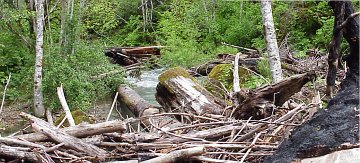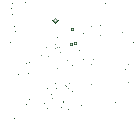~~* The Singing Falls Stream Restoration Project *~~
 ϕ
ϕ
~~*Banks For Salmon*~~
Many people would like to simplify their lives-- but for the sake of threatened runs of salmon, we need to keep our rivers as complicated as possible.
The wild salmon of the Pacific Northwest evolved in an extremely complex environment. Before the coming of European settlers, rivers and streams were tangled webs of channels, oxbows, sloughs, and wetlands. Waterways were choked with brush, beaver dams and downed timber. Their banks were thick with trees and overhanging bushes, providing a canopy of shade in summer and heavy load of nutrient-bearing debris--such as leaves, twigs and lichen -- in the fall.
Salmon made use of the habitats created by these diverse elements. They spawned in gravel in the riffles, rested in plunge pools, foraged in backwater areas and took shelter under the overgrown banks and fallen trees.
As our society has modified the landscape for agriculture, forestry, industry and urbanization, much of this complex “structure“ within river systems has been lost. Streams are often channelized, losing their meanders, shallows and pools and becoming ditches through which water is sent. Many rivers have been stripped of their bordering “riparian“ forests.

Large and small woody debris is home for the coho
The loss of stream bank vegetation affects salmon in numerous way. Salmon need water temperatures in the 42-65 degree Fahrenheit range (with 55-58) degrees being ideal); unshaded streams stripped of their sheltering canopies of leaves frequently reach the upper end of this range, stressing the salmon, and in warmer areas can reach lethal levels. The lack of shrubs, roots and grasses overhanging the bank deprives juvenile salmon of hiding places from predators. Exposed banks can erode, covering spawning gravel with sediment deadly to developing eggs And in the natural system, the leaves and other debris which fall into the stream from riparian vegetation provide food for the insect larvae (“nymphs”) and small crustaceans which are in turn eaten by maturing salmon. Removal of this vegetation breaks some important links in the food chain.
A recent United States Forest Service study indicated that 90% of the streams in our region are missing key habitat components for salmon, due to loss of streamside vegetation from grazing, logging, and development, removal of logs and brush from within the stream, road construction and other causes. The good news from the same study, though, is that restoration of most streams for salmon is quite feasible given cooperation between fishery managers and landowners.
Landowners whose property borders a stream or river can do a great deal to increase the survival of salmon by increasing the habitat complexity. The first step, of course, is to preserve the stream-bank vegetation that is already there. All too many landowners, meaning no harm to fish, strip away brush and trees to “improve the view,” or even, ironically, to improve fishing access.
Among other steps to consider:
Stabilize exposed banks by planting ground cover (using native plant species). For more information on how to combat erosion, contact your local watershed group, soil and water conservation district, or county extension office).
Re-vegetate stream banks; here again, be sure to use native trees, shrubs, and other plants. An ambitious but worthwhile project would be to remove non-native blackberry vines and replace them with fish-friendly shrubs and trees. (Remove by mowing and burning--don't use herbicides near the creeks).
Protect wetlands on your property. They help absorb floods, filter pollutants, and store and release water slowly to maintain stream flows during the summer.
Fence animals away from streams. Animals can operate inexpensive nose-pumps to get water. (Cost share programs, tax incentives, and labor assistance may be available. Check with your local watershed group, soil and water conservation district, or county extension office).
Never remove woody debris (logs, branches, beaver dams and other material) from the river or stream bottom.
Never throw leaves or grass clippings in the stream. As the decay they use up the oxygen in the water.
Minimize or eliminate use of herbicides, pesticides and fertilizers. If you must use them, be very careful during application (for instance, don't use them in windy conditions or when rain is likely). When these chemicals reach waterways in run-off they can harm fish and water quality.
Keep banks free from trash. At best, refuse does the habitat no good, and at worst it may leak toxins into the water or be mistaken for food by fish and other aquatic organisms.
For more information on what you can do at home to help salmon recovery efforts in the Pacific Northwest, please contact your local watershed restoration group, soil and water conservation district, or Pacific States Marine Fisheries Commission, 45 SE 82nd Dr., Suite 100, Gladstone, OR 97027-2522.
stream index
top






